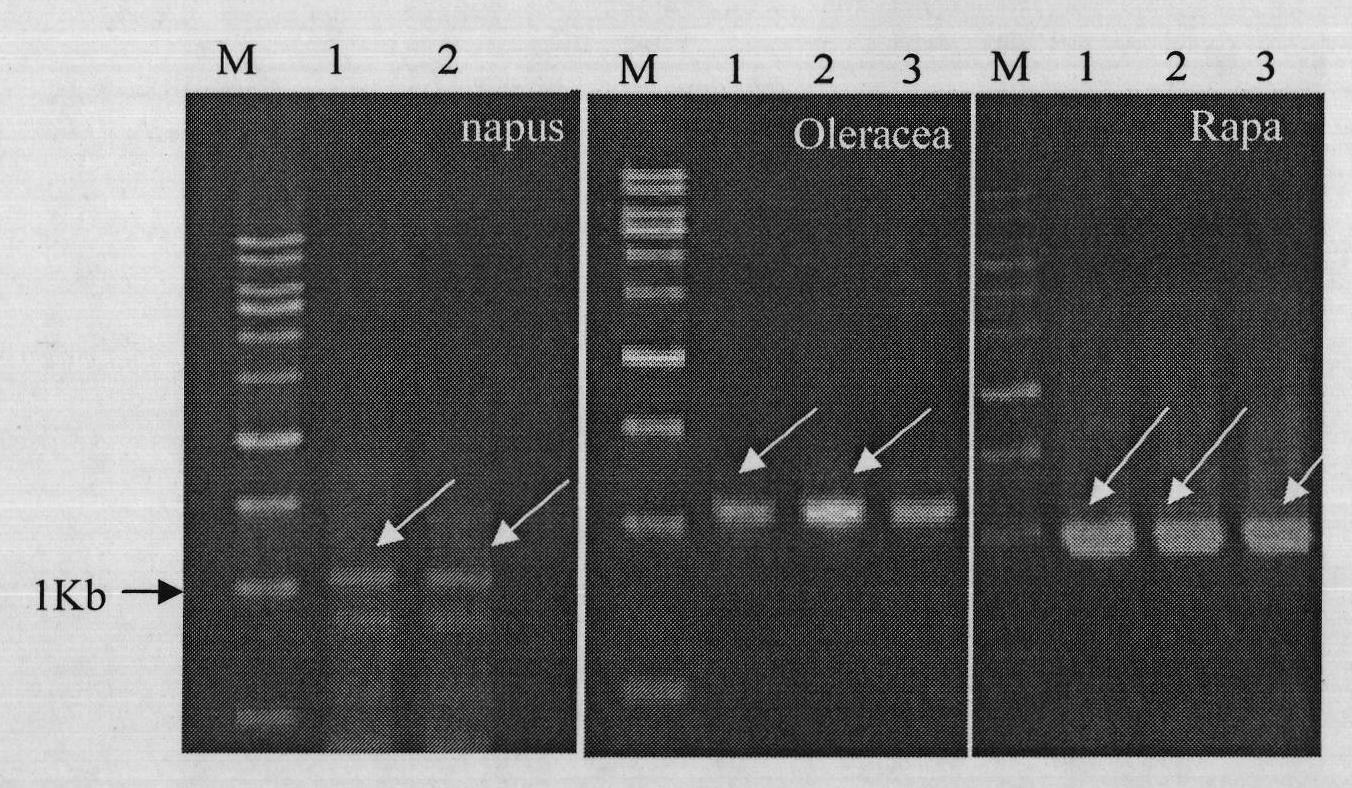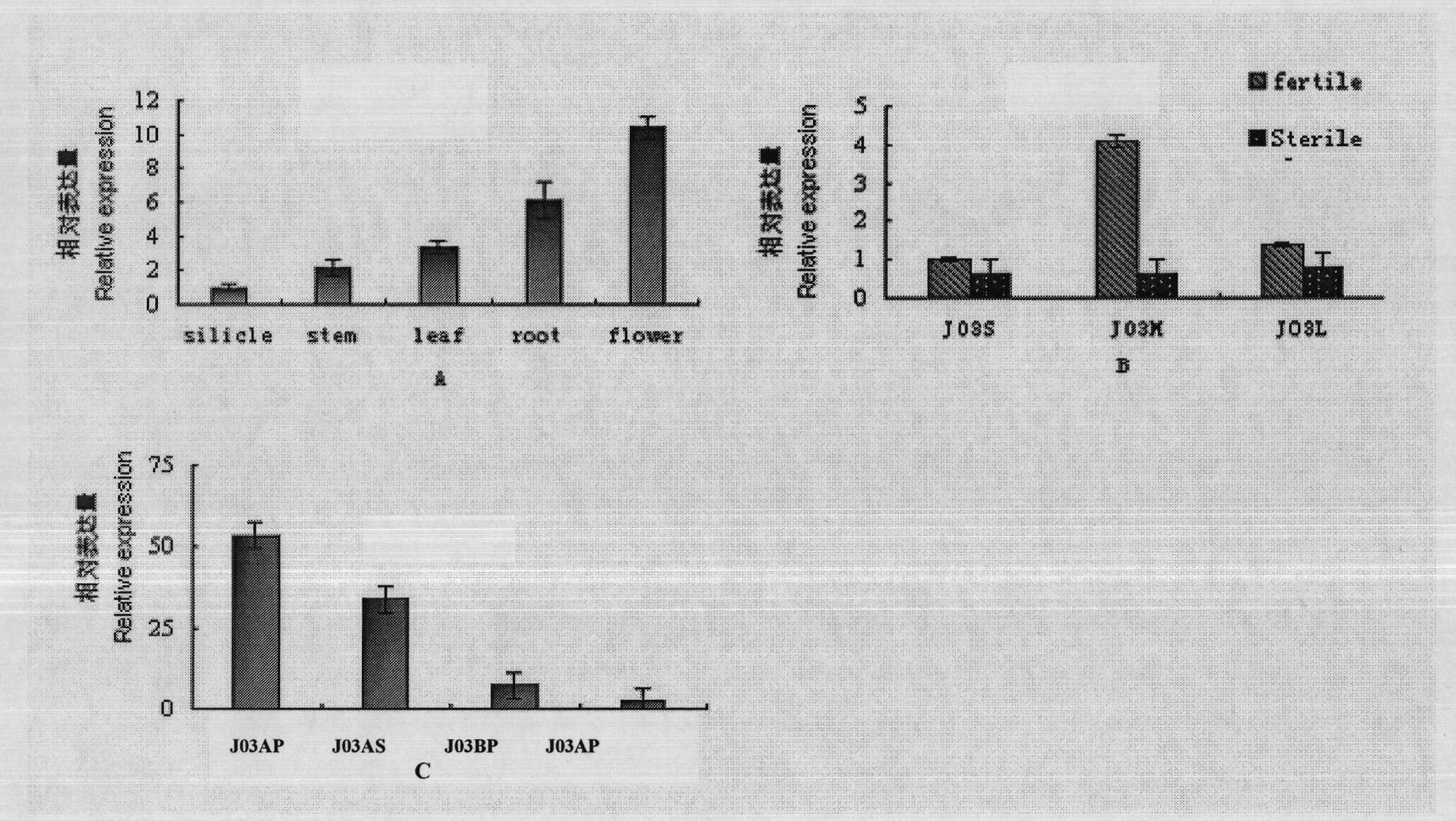PDF1 gene for controlling plant pollen fertility, and preparation method and application thereof
A technology of fertility and inhibitory factors, which is applied in the field of plant genetic engineering and biology, can solve the problems of low expression level, no other genes found, poor gene conservation, etc.
- Summary
- Abstract
- Description
- Claims
- Application Information
AI Technical Summary
Problems solved by technology
Method used
Image
Examples
Embodiment 1
[0083] Cloning of PDF1 homologous genes and BnPDF1 expression pattern analysis:
[0084] 1. Cloning of PDF1 homologous gene:
[0085] Carry out the extraction of total RNA according to the requirement of Trirol extraction kit (mentioned above), specific method is as follows: get respectively 0.05-0.1g of Brassica oleracea, Brassica napus, Chinese cabbage-type rape leaf sample, grind to powder in liquid nitrogen, RNA was extracted according to the requirements of the Trirol extraction kit. The extracted total RNA was dissolved in 60uL of RNase-free double distilled water. DNase I (described above) removes possible residual DNA. A protein detector (DU 650 BECKMAN, USA) was used to detect the light absorption values of RNA at 260 nm and 280 nm, respectively, and the purity and concentration of RNA were identified by 1% (mass volume ratio) agarose gel electrophoresis. Use the RNA obtained above as a template to carry out reverse transcription according to the following scheme...
Embodiment 2
[0108] Example 2.: microRNA-PDF1 vector construction, Arabidopsis transformation and PCR detection:
[0109] 1. Vector construction of microRNA-PDF1
[0110]The vector was constructed according to the method listed in "2010 Project of Arabidopsis" (http: / / wmd3.weigelworld.org / cgi-bin / webapp.cgi?page=Home; project=stdwmd). The selected target sequence is: AATUTUTATATUUTGTUGAG, and the corresponding Oligo DNA is: TTAGAGACTATAGGACAGCTC. Carrier structure such as image 3 shown.
[0111] Then microRNA-PDF1 was transferred into Agrobacterium tumefaciens EHA105 (purchased from Dalian Bao Biological Products Co., Ltd., hereinafter the same) using the freeze-thaw method (described above), and coated with 50 μg / mL ampicillin and rifampicin ( 50 μg / mL) of LB solid (recipe is as follows: Weigh 10 grams of tryptone, 5 grams of yeast extract and 10 grams of sodium chloride, and 8 grams of agar are dissolved in distilled water in turn, and the volume is set at 1000 ml. Packed in 500 In ...
Embodiment 3
[0126] Example 3: Phenotype observation of transgenic Arabidopsis:
[0127] During the flowering period of Arabidopsis, select the flowers that have leaked at the top of each branch but have not yet opened, and use a dissecting needle to poke the flower buds. Anthers and pollen were observed under a magnifying glass (3 times) and a stereomicroscope (OLYMPUS SZ61TRC). Anthers were isolated with a dissecting needle, and the anthers soaked in Alexander's staining solution were heated overnight in a 40°C water bath (Alexander, M.P. Differential staining of aborted and non-aborted pollen. As mentioned above), the microspores were observed under a microscope (OLYMPUS IX71) by the tablet method. The degree of abortion of microspores was determined by observing and counting the ratio of normal microspores (stained orange) and aborted microspores (stained green). Arabidopsis anther frozen section and hematoxylin staining methods refer to the Arabidopsis floral organ frozen section te...
PUM
 Login to View More
Login to View More Abstract
Description
Claims
Application Information
 Login to View More
Login to View More - R&D
- Intellectual Property
- Life Sciences
- Materials
- Tech Scout
- Unparalleled Data Quality
- Higher Quality Content
- 60% Fewer Hallucinations
Browse by: Latest US Patents, China's latest patents, Technical Efficacy Thesaurus, Application Domain, Technology Topic, Popular Technical Reports.
© 2025 PatSnap. All rights reserved.Legal|Privacy policy|Modern Slavery Act Transparency Statement|Sitemap|About US| Contact US: help@patsnap.com



